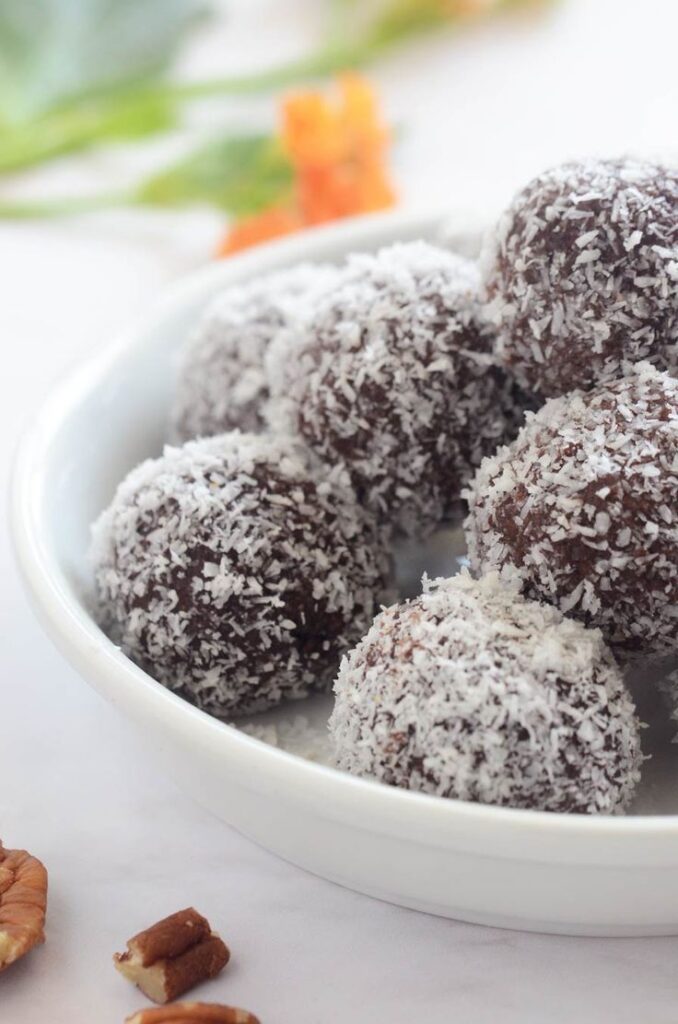
Sure! Here’s a longer, more detailed article on Kókuszgolyó (Hungarian Coconut Balls), diving into its history, variations, and a step-by-step guide to making them at home.
Kókuszgolyó: The Deliciously Sweet Hungarian Coconut Balls
If you’ve ever had the pleasure of visiting Hungary or sampling Hungarian desserts, you’ve likely encountered Kókuszgolyó—a beloved treat that’s as simple as it is irresistible. Known as Hungarian coconut balls, these delightful, no-bake confections are a staple in many Hungarian households. Whether served at birthday parties, holidays, or family gatherings, Kókuszgolyó is a dessert that brings comfort and joy.
In this article, we’ll explore the origins of Kókuszgolyó, how to make them, their place in Hungarian culture, and some variations that make this treat even more versatile. Whether you’re a seasoned baker or a novice looking for a fun, easy recipe, this guide will have you ready to whip up these delectable coconut balls in no time!
The History of Kókuszgolyó
While the exact origins of Kókuszgolyó are not clear, coconut-based sweets have been a part of Hungarian cuisine for centuries. Coconut, as an ingredient, became more widespread in European desserts in the 19th century, and by the mid-20th century, Kókuszgolyó had become a popular treat in Hungary.
The simplicity of the recipe, using common pantry ingredients like biscuits, cocoa, butter, and desiccated coconut, made it an ideal dessert for Hungarian families. It became especially popular during communist Hungary in the 1970s and 1980s, as it was a cost-effective dessert that required no baking and could be easily prepared by children or novice cooks.
Over the years, Kókuszgolyó has remained a beloved dessert in Hungarian households. It’s often served at celebrations, as an afternoon snack, or as a sweet accompaniment to coffee.
Ingredients for Kókuszgolyó
The beauty of Kókuszgolyó lies in its simplicity. This no-bake treat requires only a few ingredients that are easy to find and inexpensive. Here’s a detailed look at the ingredients used in the traditional recipe:
- Crushed Biscuits: The base of Kókuszgolyó is made from crushed biscuits, such as digestive biscuits or graham crackers. These cookies provide a crunchy texture and help bind the coconut mixture together. Depending on the type of biscuits you use, you might want to adjust the amount of sugar in the recipe to avoid making the balls too sweet.
- Powdered Sugar: To add sweetness to the coconut mixture, powdered sugar is used. It dissolves easily and blends into the dough, giving the balls a smooth texture.
- Cocoa Powder: A key ingredient that adds richness and depth to the flavor. Cocoa powder not only deepens the color of the coconut balls but also contributes a lovely chocolatey taste that contrasts beautifully with the coconut.
- Butter: Butter helps to bind all the ingredients together and gives the coconut balls their richness. It also adds a smooth, creamy texture.
- Milk: A small amount of milk is added to moisten the mixture. The amount of milk can be adjusted depending on the consistency you desire.
- Desiccated Coconut: This is the star ingredient! Desiccated coconut provides the familiar tropical flavor and texture that makes Kókuszgolyó so unique. You’ll need a good amount to coat the balls and incorporate into the dough.
- Optional Rum or Rum Essence: For a little extra flavor, some recipes include a splash of rum or rum essence. It adds a hint of warmth and sophistication to the otherwise simple coconut flavor.
How to Make Kókuszgolyó: Step-by-Step Guide
Making Kókuszgolyó is a straightforward process that doesn’t require any special skills or equipment. Here’s a detailed step-by-step guide to help you create these mouthwatering coconut balls:
Step 1: Prepare the Dry Ingredients
Start by crushing your biscuits into small pieces. You can do this by placing the biscuits in a plastic bag and using a rolling pin to crush them, or you can use a food processor for a finer texture. The key is to make sure the pieces aren’t too large, as they need to blend into the dough smoothly.
In a large mixing bowl, combine the crushed biscuits, powdered sugar, cocoa powder, and half of the desiccated coconut. Stir until all the dry ingredients are well-mixed.
Step 2: Add Wet Ingredients
Next, add the melted butter, milk, and vanilla extract to the dry ingredients. Stir everything together until the mixture becomes a sticky dough. If you’re using rum or rum essence, add it at this stage as well. If the mixture feels too dry or crumbly, you can add a bit more milk to get the right consistency.
Step 3: Form the Balls
Once the dough is ready, take small portions of the mixture and roll them into balls about the size of a walnut. You can use your hands to shape them, or if you prefer, you can use a tablespoon to portion out the dough and then roll it into a ball.
Step 4: Coat the Balls in Coconut
Place the remaining desiccated coconut in a shallow bowl. Roll each ball in the coconut until it is completely coated. The coconut not only adds flavor but also gives the balls a beautiful, snowy appearance.
Step 5: Chill the Kókuszgolyó
Once all the balls are coated, place them on a tray lined with parchment paper or a plate. Refrigerate them for at least 30 minutes to allow them to firm up. This step ensures that the coconut balls hold their shape and become more cohesive.
Step 6: Serve and Enjoy
After chilling, your Kókuszgolyó are ready to be served! These coconut balls are perfect as a sweet snack, a dessert at a gathering, or even as a gift wrapped up in a cute box. They can be stored in the fridge for up to a week, making them an ideal treat to prepare in advance.